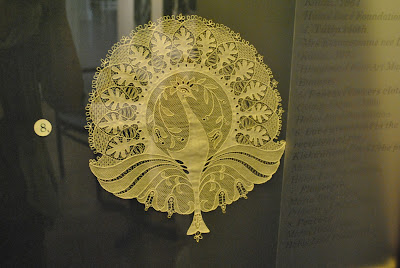Lace is an openwork fabric, patterned with open holes in the work, made by machine or by hand. The holes can be formed via removal of threads or cloth from a previously woven fabric, but more often open spaces are created as part of the lace fabric. Lace-making is an ancient craft. True lace was not made until the late 15th and early 16th centuries. (WIKI)
Embroidery of garments was universal in the middle ages. To obtain the desired effect, gold or silver thread and silk were applied to contrasting colors Nowadays lace is often made with cotton thread, although linen and silk threads are still available. Manufactured lace may be made of synthetic fibres.
There are many types of lace, classified by how they are made.
In the late 16th century there was a rapid development in the field of lace. There was an openwork fabric where they achieved combinations of open spaces and dense textures form designs. These forms of lace were dominant in both fashion as well as home décor during the late 1500s. For enhancing the beauty of collars and cuffs, needle lace was embroidered with loops and picots.
Since the 16th century, needlepoint lace has epitomized luxury and elegance. Although it most likely developed in Italy for ecclesiastical use, it was soon exported throughout Europe and produced in several places. Needle lace became an essential part of every 17th century court costume -- male and female -- and elaborate ruffs, collars and cuffs appeared in endless European portraits. Its most serious competition came from the bobbin lace of Flanders, and that primarily in the 18th century.
Back in those days lace was more personalized and unique. Women used lace as a character of their personality, if the lace had complicated in forms or design it meant that person had fortune.
The design of the Lace always followed the prevalent style of the ornamentation of the day. Lace works are different by execution and time, like: linen and embroidery cut work, darned netting, drawn work, knotted lace, plaited lace, etc.
Lace today:
I hope you liked my little documentation. If you have questions for us don't forgot to live one at the ASK bar.
Embroidery of garments was universal in the middle ages. To obtain the desired effect, gold or silver thread and silk were applied to contrasting colors Nowadays lace is often made with cotton thread, although linen and silk threads are still available. Manufactured lace may be made of synthetic fibres.
There are many types of lace, classified by how they are made.
In the late 16th century there was a rapid development in the field of lace. There was an openwork fabric where they achieved combinations of open spaces and dense textures form designs. These forms of lace were dominant in both fashion as well as home décor during the late 1500s. For enhancing the beauty of collars and cuffs, needle lace was embroidered with loops and picots.
Lace techniques:
Since the 16th century, needlepoint lace has epitomized luxury and elegance. Although it most likely developed in Italy for ecclesiastical use, it was soon exported throughout Europe and produced in several places. Needle lace became an essential part of every 17th century court costume -- male and female -- and elaborate ruffs, collars and cuffs appeared in endless European portraits. Its most serious competition came from the bobbin lace of Flanders, and that primarily in the 18th century.
Back in those days lace was more personalized and unique. Women used lace as a character of their personality, if the lace had complicated in forms or design it meant that person had fortune.
The design of the Lace always followed the prevalent style of the ornamentation of the day. Lace works are different by execution and time, like: linen and embroidery cut work, darned netting, drawn work, knotted lace, plaited lace, etc.
Lace today:
I hope you liked my little documentation. If you have questions for us don't forgot to live one at the ASK bar.
Have a nice Sunday!

















































